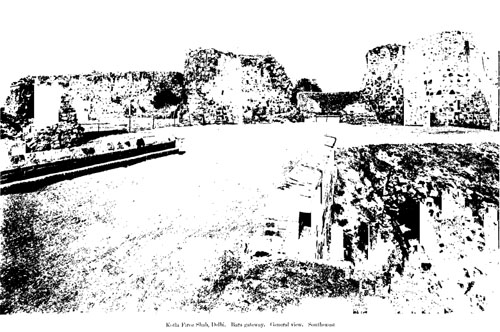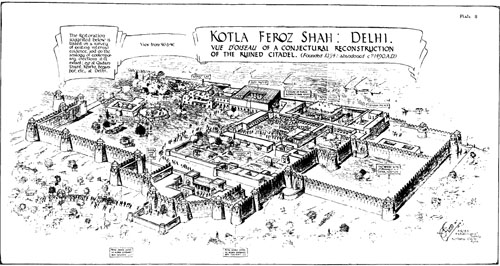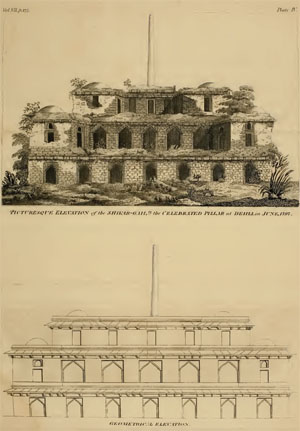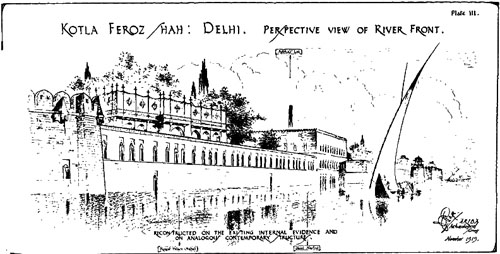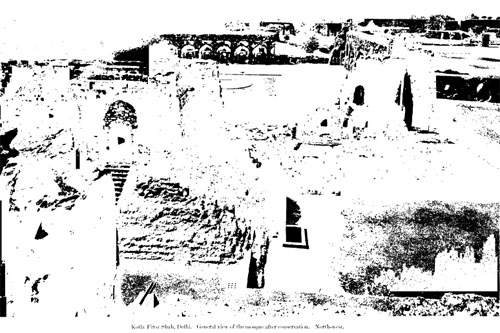Memoirs Of the Archaeological Survey of India, No. 52
by J.A. Page, A.R.I.B.A., Late Superintendent, Archaeological Survey of India
With a Translation of Sirat-i-Firozshahi by Mohammad Hamid Kuraishi, B.A., Superintendent, Archaeological Survey of India
1937
NOTICE: THIS WORK MAY BE PROTECTED BY COPYRIGHT
YOU ARE REQUIRED TO READ THE COPYRIGHT NOTICE AT THIS LINK BEFORE YOU READ THE FOLLOWING WORK, THAT IS AVAILABLE SOLELY FOR PRIVATE STUDY, SCHOLARSHIP OR RESEARCH PURSUANT TO 17 U.S.C. SECTION 107 AND 108. IN THE EVENT THAT THE LIBRARY DETERMINES THAT UNLAWFUL COPYING OF THIS WORK HAS OCCURRED, THE LIBRARY HAS THE RIGHT TO BLOCK THE I.P. ADDRESS AT WHICH THE UNLAWFUL COPYING APPEARED TO HAVE OCCURRED. THANK YOU FOR RESPECTING THE RIGHTS OF COPYRIGHT OWNERS.
Besides the works, particularly by Muslim historians referred to by Mr. Page in his Memoir, there exists another trustworthy and contemporary account of Firoz Shah's reign as narrated in the pages of Sirat-i-Firozshahi, a Persian manuscript in Nastaliq characters deposited in the Oriental Public Library at Bankipore and enlisted in its Catalogue as No. 547. From the Catalogue it appears that nothing is known about the author of Sirat-i-Firozshahi but the verse at the end of the manuscript assigns the work to A.H. 772 (A.D. 1370). i.e., the twentieth year of the reign of Firoz Shah. Sirat-i-Firozshahi thus chronicles the events of the earlier part of Firoz Shah's reign.God said it, I believe it, That settles it.
-- Memoirs Of the Archaeological Survey of India, No. 52: A Memoir on Kotla Firoz Shah, Delhi, by J.A. Page, A.R.I.B.A., Late Superintendent, Archaeological Survey of India, With a Translation of Sirat-i-Firozshahi by Mohammad Hamid Kuraishi, B.A., Superintendent, Archaeological Survey of India, 1937
The text is known from a Persian manuscript in the Oriental Public Library at Bankipore, Patna dated 1002 A.H. [???] [1593-1594 A.D. [???]] Mohammad Hamid Kuraishi translated a portion of the work that concerned the transport of the Asokan column from Topra to Firuzabad. His translation appears in the monograph on the monument by J. A. Page in the Memoirs of the Archaeological Survey of India in 1937....
***This pillar, high as the heaven, is made of a single block of stone and tapers upward, being broad at the base and narrow at the top.
Seen from a hundred farsang it looks like a hillock of gold, as the Sun when it spreads its rays in the morning.
No bird -- neither eagle, nor crane -- can fly as high as its top; and arrows, whether khadang or khatai, cannot reach to its middle.
If thunder were to rage about the top of this pillar, no one could hear the sound owing to the great distance [between the top of the pillar and the ground].
O God! how did they lift this heavy mountain [i.e., the pillar]?; and in what did they fix it [so firmly] that it does not move from its place?
How did they carry it to the top of the building which almost touches the heavens and place it there [in its upright position]?
How could they paint it all over with gold, [so beautifully] that it appears to the people like the golden morning!
Is it the lote-tree of paradise [tuba] which the angels may have planted in this world or is it the heavenly ''sidrah" which the people imagine to be a mountain?
Its foundations have been filled with iron and stone; and its trunk and branches [i.e., shaft and capital] are made of gold and corals.
Sirat-i Firuz Shahi, pp. 41-42. The verses included in the Sirat are considered to be by the poet Maulana Mutahir of Karra, whose work was freely borrowed by the author without attribution. See Riazual Islam, "The Age of Firoz Shah," Medieval India Quarterly (1950) i/I, pp. 32-33. The poet’s description is based on the column’s actual attributes. Firuz Shah’s stepped pyramidal form does resemble the slopes of a mountain and the elevated position of the lat made it visible at great distances. Its light color and its polished surface reflect the sunlight and earned its reputation as the Minar-i zarin or golden minar. The lat and its pyramidal foundation thus embody the physical characteristics of height, solid form, and luminescence which the poet describes. The poet’s allusion to the universal axis (axis mundi) and the form of a mountain are symbols commonly attributed to pillars, albeit Buddhist, Hindu, or Muslim. ‘Afif, Ta’rikh, p. 350, states that the column was designated the Minar-i zarin, or golden column, because of its gold finial. The Sirat-i Firuz Shahi (p. 41) states, probably incorrectly, that the column itself was gilded ...
Hyperbolic descriptions of the monument’s height given in verses of the Sirat-i Firuz Shahi are clearly exaggerated ...
Viewed from a distance, the monument appears to sweep upward, no doubt a desired effect and one which conforms to the exaggerated descriptions of its height in the Sirat-i Firuz Shahi.
Neither Khwajah Nizamuddin Ahmad Bakshi [1551-1621 CE] or Firishta [1560-1620 CE] [or Ziauddin Barani (1285–1358 CE )] were aware of ‘Afif's Tarikh-i Firuz Shahi [or Mr. Anonymous’ Sirat-i Firuz Shahi] ...
The Asokan column is not mentioned by any contemporary author ...
The Sirat-i Firuz Shahi mentions that the pillar was traditionally thought to have been located next to a temple erected some four thousand years in the past. Also, the Sirat relates the story that Mongol kings tried to split the pillar by fire, unsuccessfully. /// ‘Afif relates that these pillars were walking sticks of a giant, Bhim, who lived during the time of the Pandavas, an age equivalent to the Homeric Age of Greece ...
The details of the discovery and transport of this Asokan lat are provided in the Sirat-i Firuz Shah /// ‘Afif mentions the transport of two columns, the second being placed in the kuskh-i shikar ...
The Sirat-i Firuz Shahi reiterates ‘Afif’s assertion that the pillar was transported and erected in the Firuzabad mosque after that mosque had been built ...
The Sirat contends that the lat was to serve as a minar and was consciously adopted from serving an infidel purpose for use in a Muslim edifice /// Both authors ['Afif and Anonymous of the Sirat] corroborate that it functioned as a minar for the adjacent mosque ...
‘Afif mentions in the Ta’rikh-i Firuz Shahi that neither Brahmans or Hindu devotees of Topra were able to decipher them /// The author of the Sirat-i Firuz Shahi concurs that the inscriptions were "unintelligible."…
The Sirat mentions that the discovery of the lat occurred in 769/1367, after the conquest of Sind /// ‘Afif mentions the transport of two columns, the second being placed in the kuskh-i shikar, the event taking place in 764/1367 ...
‘Afif states that Firuz Shah brought back two pillars to Firuzabad. One of these was erected in the palace (kushk) at Firozabad, near the jami masjid, and was designated the Minara-i zarin, or Golden Column, and the second pillar was erected in the kushk-i shikar /// The Sirat-i Firuz Shahi also makes several references to the Topra column as a minar ...
-- The Architecture of Firuz Shah Tughluq, Dissertation Presented in Partial Fulfillment of the Requirements for the Degree Doctor of Philosophy in the Graduate, School of The Ohio State University, by William Jeffrey McKibben, B.A., M.A., 1988
Table of Contents:
• Preface
• Firozabad, the town
• Kotla Firoz Shah, the Citadel
• The Lat Pyramid
• The connecting bridge
• The Mosque
• The river front and Royal palaces
• Interior courts and Gates
• The Baoli
• Water Tanks and Ducts
• The Citadel Walls; Main entrance bay
• Defence of the walls
• Contemporary accounts of the Citadel
• Firozabad the Royal retreat
• Features of the Palaces
• The Corps of the Palace Slaves
• The Sultan emerges in State
• Events at the Citadel
• The Sultan’s Gardens
• The Sultan’s buildings
• His Chief Architect
• The Royal establishments and domestic arrangements
• Subsequent History of the Kotla
• The Sultan retires in favour of his son Muhammad Khan
• Flight of Muhammad Khan and his supersession by Sultan Firoz’s grandson, Tughlaq Shah
• Death of Firoz Shah
• Death of his successor Tughlaq Shah and enthronement of Muhammad Khan at Samana
• Death of Sultan Muhammad
• Succession of Prince Mahmud at Jahanpanah
• Rebellion and rival sovereignty of his cousin Nasrat Shah at Firozabad
• Timur’s invasion
• Subsequent History
• Appendix: Translation of the Topra pillar edicts of King Devanampriya
• Index
• Translation of the extracts from Sirat-i-Firozshahi [Folios 91 (b) to 105 (b)]
• Transcript of Sirat-i-Firozshahi [Folios 91 (b) to 105 (b)] with illustrations
• LIST OF PLATES.
o Plate I. — Kotla Firoz Shah, Delhi. Bara gateway. General view. (South-west).
o Plate II. — Kotla Firoz Shah, Delhi; Vue D'oiseau of a conjectural reconstruction of the ruined citadel.
o Plate III. — Kotla Firoz Shah, Delhi; Perspective view of river front.
o Plate IV. — Kotla Firoz Shah, Delhi; General view of the mosque. (North-west).
o Plate V. — Kotla Firoz Shah, Delhi; view of the Lat Pyramid.
o Plate VI. — (Coloured.) Kotla Firoz Shah, Delhi; IIIustrations from Sirat-i-Firozshahi
(а) Removing wheels of the cart from one side and tying ropes and pulling up the pillar to place it in the boat.
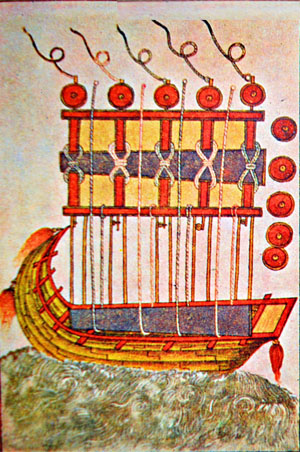
(b) Arrival of boat with pillar on the bank of the Jumna (near Delhi), tying ropes to the pillar to remove it from the boat and place it on the cart.
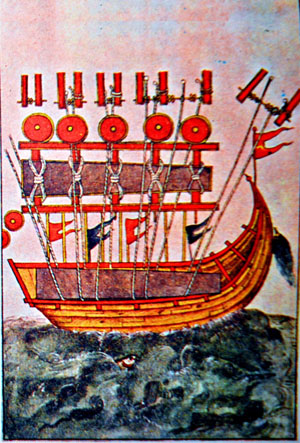
(c) The monolith being carried on the ladha (cart) towards the town of Firozabad (Delhi).
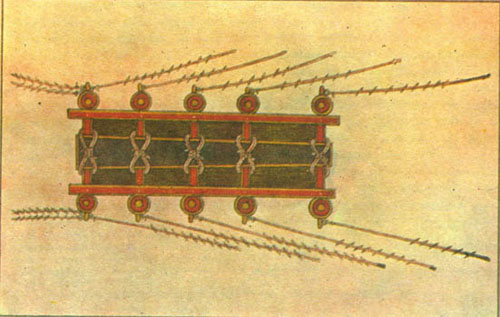
(d) Arrival of the cart with pillar in front of the mosque of Firozabad (Delhi).
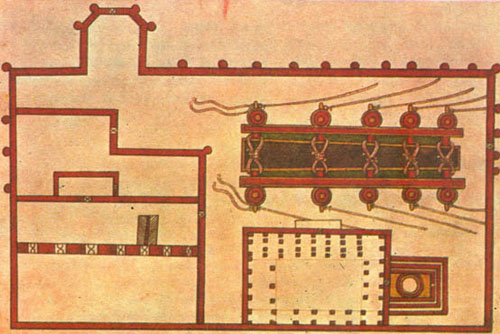
• LIST OF ILLUSTRATIONS APPEARING IN THE TRANSCRIPT OF SIRAT-I-FIROZSHAHI.
o Fig. 1. — Erection of piers and pulleys and tying of ropes, for taking down the stone pillar.
o Fig. 2 . — Pasheb on which the stone pillar would rest while taken down.
o Fig. 3. — Erection of pulleys and raising the pillar in order to place it on the ladha (cart).
o Fig. 4. — Arrival of the ladha with the stone pillar, at the bank of the Jamna river.
o Fig. 5. — Constructing the foundations of a structure, 61 yards square thereon to set up the pillar.
o Fig. 6. — Building of the first storey and raising the pillar on its top by means of ropes.
o Fig. 7. — Plan of the second storey.
o Fig. 8. — Raising the pillar two yards at a time, first at one end and then at the other.
o Fig. 9. — Third storey of the structure on which the pillar was set up.

